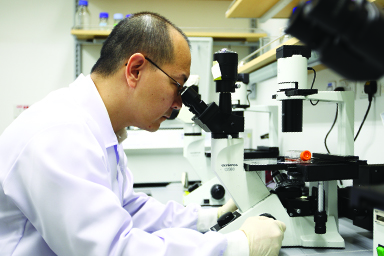NUHS Institutions will NEVER ask you to transfer money or disclose bank details over a call.
If in doubt, call the 24/7 ScamShield helpline at 1799, or visit the ScamShield website at www.scamshield.gov.sg.
Make an appointment or seek a second opinion here.
Leukaemia is cancer of the blood cells. It starts in the bone marrow, where blood cells are made. It causes an uncontrolled production of abnormal white blood cells, called leukaemia cells. These cells do not function normally and over time, they crowd out the normal blood cells and usually lead to anaemia, bleeding and infections.
Most Leukaemia patients do not have any identifiable risk. However, the more common risk factors include:
*People who think they may be at risk should discuss this with their doctor.
Leukaemia is usually grouped into either chronic (conditions get worse slowly) or acute (conditions get worse quickly). This can be further sub-grouped into the following:
Acute Leukaemia
Acute Myelogenous Leukaemia (AML)
AML is an aggressive type of leukaemia whereby there are too many immature myeloid cells (myeloid blasts) in the blood and bone marrow. AML is the most common type of leukaemia.
Pre-chemotherapy work-up for AML would include a number of blood tests and heart scan. These are essential to determine the suitability of the patient for intensive chemotherapy. A central venous line will be inserted via a vein on the arm to facilitate delivery of chemotherapy and other intravenous medication. It also spares the patient from repeated venupunctures for the purpose of blood tests. Generally, the treatment consists of one to two cycles of induction chemotherapy followed by consolidation therapy.
The chemotherapy process consists of one to two types of chemotherapeutic agents such as cytarabine, idarubicin or daunorubicin. After induction chemotherapy, reassessment of the bone marrow will be carried out to confirm the remission status. The consolidation therapy can be further broken down into three cycles of chemotherapy (for standard risk or favorable risk patients) or allogeneic stem cell transplant (for high risk patients). Thereafter, the patient will be reviewed regularly in the clinic.
Acute Lymphocytic Leukaemia (ALL)
ALL is a fast-growing type of leukaemia whereby there are too many immature lymphoid cells (lymphoid blasts) in the blood and bone marrow. ALL is the most common type of leukaemia in young children.
The pre-chemotherapy work-up is the same as per AML. Younger adults (below 30 years old) will be offered a paediatric-inspired protocol. Those above 30 years old will be offered the standard adult protocol for ALL (HyperCVAD Protocol). Risk stratification of ALL based on genetic and MRD (residual disease) studies will help determine the high risk group for eventual allogeneic stem cell transplant. Those with standard risk disease will be offered consolidation chemotherapy followed by maintenance therapy. Thereafter, patients will be monitored regularly in the clinic.
Chronic Leukaemia
Chronic Myeloid Leukaemia (CML)
CML is another slow-growing type of leukaemia in which too many myeloid cells are produced. Leukaemic blasts only make up a small percentage of this cancer type and CML mainly affects adults
The pre-treatment work-up for CML is much simpler, comprising mainly of a few blood tests to assess the functionality of the organs. The main therapeutic agent is oral tyrosine kinase inhibitor (TKI) which is a targeted therapy. Almost all patients will respond to this treatment. All patients will undergo bone marrow assessment at 3 months, 6 months and 12 months. The TKI will be continued indefinitely. Patients should be on long term follow-up for continuous monitoring of disease progression.
Chronic Myelomonocytic Leukaemia (CMML)
CMML is a type of leukaemia in which there are too many monocytes (white blood cells) in the blood. There are two types of CMML – type 1 and type 2.
Other forms of Chronic Leukaemia which are considered rare include:
The different types of leukaemia will in turn determine the symptoms and ultimately the treatment prescribed.
Patients who have chronic leukaemia may not experience any symptoms and their condition is usually detected from routine blood tests. However, for patients with acute leukaemia and as the conditions worsen for chronic leukaemia patients, symptoms may include:
Most often these symptoms can also be caused by problems other than cancer, only a doctor can tell for sure. For an accurate diagnosis, a doctor should be consulted if the symptoms above occur.
If you experience any of the symptoms mentioned, the doctor will need to run some tests to find out what’s causing the problems. Your doctor may ask about your personal and family medical history.
You may have one or more of the following tests.
Physical Exam
Your doctor checks for swollen lymph nodes, spleen, or liver.
Blood Tests
Your doctor will do a complete blood count to check the number of white blood cells, red blood cells, and platelets. Leukaemia causes a very high level of white blood cells, and may also lead to low levels of platelets and haemoglobin, which is found inside red blood cells.
Biopsy
If leukaemia cells are found, the next step is to run other tests to determine what type of leukaemia you have or other signs of problem.
There are different treatments available for depending on the type of leukaemia. Other factors include your age, your overall health, and your own preferences. The types of treatment that may be prescribed are as follows.
Chemotherapy
Chemotherapy is the use of drugs to help kill leukaemia cells. Depending on the type of leukaemia, you may receive a single drug or a combination of two or more drugs. The drugs are given into a vein, by mouth or into the cerebrospinal fluid. Once the drugs enter our system, they will spread throughout the body.
Chemotherapy is usually given in cycles. Each treatment cycle is followed by a rest period. You may have your treatment in a clinic, at the doctor’s office. Some patient may need to stay in hospital for treatment.
Targeted Therapy
Targeted therapy is the use of drugs to block the growth of leukaemia cells, through the interference of specific targeted molecules. The drugs can be used to stop cancer cells progression, cause cancer cells death and even stimulate the immune system to recognise and destroy cancer cells, while sparing the normal cells.
Only certain subtypes of leukaemia will benefit from targeted therapy. This will depend on the findings of the genetic study.
Biological Therapy
Biological therapy is the use of substances that bolster one’s immune response to leukaemia. This can be administered through the vein or injected under the skin into a muscle. The drugs can either slow the growth of the leukaemia cells or helps the immune system destroy the cells.
Radiation Therapy
Radiation therapy is a cancer treatment that uses high energy x-rays or other types of radiation to kill leukaemia cells or keep them from growing. In this case, radiation will be targeted at the spleen, the brain or other parts of the body where leukaemia cells have collected.
Stem Cell Transplant
A stem cell transplant is the replacement of the abnormal bone marrow with stem cells or marrow free of leukaemiafrom a compatible donor.
Before the stem cell transplant, you will receive either chemotherapy or radiation therapy in high dosages. In some cases, even both may be prescribed. This will destroy all your leukaemia cells and normal blood cells in your bone marrow. After which, you will receive the healthy stem cells through a large vein.
The healthy stem cells may come from you or from someone who donates their stem cells to you:

Leukaemia Care Approach

Leukaemia Care Team

Leukaemia Online Resource Library

Patient Support Groups

Leukaemia Clinical Trials

Leukaemia Resesarch